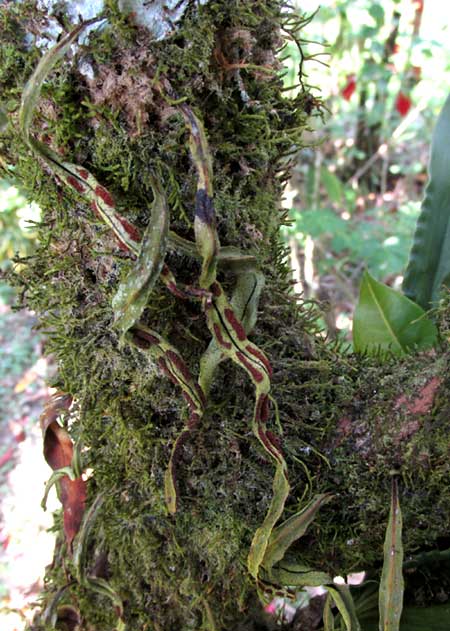Excerpts from Jim Conrad's
Naturalist Newsletter
from the May 8, 2016 Newsletter with notes from a visit in mid April to Lacanja Chansayab in the Lacandon Reserve; elevation 200m (650ft), N16.604°, W90.917°; Chiapas, MÉXICO
STAR-SCALED FERN
In mid April when I was in the Lacandon community of Lacanja Chansayab in Chiapas's Lacandon Reserve, the lady operating the small campground where I set up my tent maintained a small area where epiphytic orchids and ferns adorned the branches of small trees. Apparently she regularly sprayed the area with a hose because the tree limbs there were much more mossy than branches on trees in the surrounding forest, and nearly all the various orchid species were in bloom, though in the nearby forest I hadn't seen any orchids blossoming.
In this artificially maintained spot, there was an unusual-looking fern with very long, slender fronds bearing large, oblong sporangium clusters -- or sori -- that were arranged in single file along both sides of the fronds' dark midribs. Below, you can see the rich-brown, elongate sori on wilted, curling fronds snaking atop a tree's dense covering of mosses:

Below, a closer look at a frond's undersurface, not only better showing the brown sori but also numerous tiny scales scattered across the fronds' surfaces:

These sori appear to have never had indusia, indusia being the very thin, often silvery membranes that may or may not partially cover fern indusia. The most commonly encountered ferns with such sori belong to the Polypody Fern Family, the Polypodiaceae, of which the North's Common Polypody and Resurrection Ferns are members. However, that's a big family whose members usually display very different frond shapes. Fortunately, an online identification key is available for keying out "Neotropical Fern Genera" here.
Our frond's distinctive features quickly keyed out to the genus Pleopeltis, in the Polypody Fern Family. More browsing on the Internet informed me that the taxonomy of that genus is a mess, and I saw that most Pleopeltis species don't look like ours.
Pleopeltis astrolepis sometimes is called the Star-scaled Fern. Its English name may reflect the fact that in 1977 it was discovered in Broward County, Florida. The species is well described in the online Flora of North America," which tells us that in Broward County "the plants are in danger of extirpation from development."
Elsewhere the species is distributed from southern Mexico and the Caribbean south through Central America to Peru and Brazil in South America.